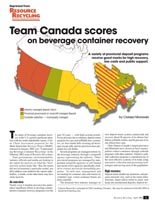A variety of provincial deposit programs receive good marks for high recovery, low costs and public support.

The status of beverage container recovery in the U.S. gained significant attention with the multi-stakeholder report, A Value Chain Assessment prepared for the Multi-Stakeholder Recovery Project (MSRP), released in January 2002 (see “Understanding Beverage Container Recycling” in the February 2002 issue of Resource Recycling).
State governments, environmentalists, industry officials and media are looking to the report for answers on what the “best” recovery system looks like. But, the report did not recommend a particular model, nor did it address costs related to the various stakeholders. Canada, on the other hand, may have some answers.
An overview Nearly every Canadian province has undertaken significant efforts to develop comprehensive container recovery programs over the past 10 years — with high-scoring results. Every province has a voluntary deposit return program for cans and refillable beer containers, six have bottle bills covering all beverages except milk, and two provinces have programs for soft drinks. Several programs are managed entirely by the beverage industry through a nonprofit agency representing the industry. Other provincial programs are managed by independent nonprofit agencies or self-funded provincial crown agencies specifically created to oversee provincial stewardship programs. In each case, management and accounting for container sales and returns by container type, versus container brand, are done centrally.

